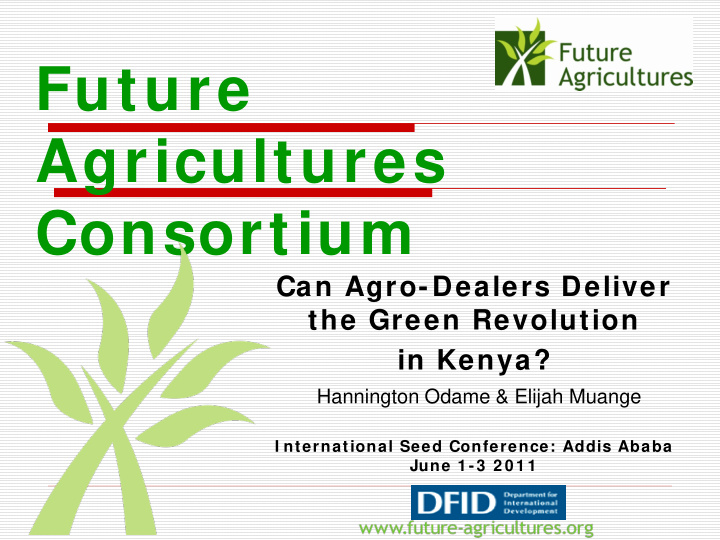



Future Agricultures Consortium Can Agro-Dealers Deliver the Green Revolution in Kenya? Hannington Odame & Elijah Muange I nternational Seed Conference: Addis Ababa June 1 -3 2 0 1 1
Main Highlights Key policy narrative: Low agricultural production (Oil crisis, rigid macro & structural policies, SAPs – SRA(2004)/Vision 2030; Problem: Low productivity’ in smallholder agriculture linked to farmers’ lack of access to agric. inputs Solution: GR type action needed, where agro-dealers supply new seeds/information to smallholder farmers and spur GR Reality on ground: Agro-dealers heterogeneous/unevenly spread– unbalanced benefits Seeds & fertiliser business is risky especially in ASALs – low/erratic demand. Diversification is key Agro-dealer model focusing on hybrid maize • Narrows choice of seeds/ crop • More benefits for high rainfall areas & larger agro-dealers Alternative/parallel input models to complement agro-dealer model.
Study Purpose and Methodology Purpose : To assess evolution & characteristics of agro-dealer in cereal seed systems & explore the extent of agro-dealer participation in GR assess the cereal seed systems; map actor networks; characterize the agro-dealer; identify points of convergence/divergence that build/break the agro-dealer agenda. Methodology: literature review; mapping actor network; analysis of narratives in policy documents; semi-structured discussions with key informants & Discussion with members Actors; agro-dealer survey of a farmer group in Machakos
Results: Cereal Seed Systems Seed systems Seed demand and supply for main cereal crops (2005) Formal – Mainly supplies Crop Formal seed (%) Informal seed (%) Maize 62 38 maize seed and high Sorghum 35 65 rainfall areas Millet 24 76 Informal – Mainly supplies Rice 24 76 seed of other cereals and Source: Adapted from Ayieko and Tschirley 2006. low rainfall areas Use of Formal Maize Seed in Different Agro-regions of Kenya Main Actors 100 90 Ministry of Agriculture 75 64 % Farmers 52 KEPHIS 50 Research Institutions 25 13 0 Seed Companies 0 High Maize Western Central Eastern Coastal Potential Zone Highlands Highlands Lowlands Lowlands Donors/NGOs Source: Authors using data from Ayieko and Tschirley 2006 Farmers
Results: Agro-dealership Policy No overall policy document – but draft ready Elaborate seed legislative framework – outdated but undergoing revision [STAK & PBAK pushing] Legislation draws from international conventions, favours formal seed system, high rainfall areas, better resourced farmers Who is an Agro-dealer? Trained and certified stockists (AGRA) No legal definition in Kenya – Seed laws recognize licensed seed merchants and sellers In practice - traders in agric. inputs, known as ‘Agro-vets’ or ‘Stockists’. Some operate ‘illegally’. Less than 50% owners manage business full-time Deal in several commodities, some non-agric.
Results: Commodity Focus of Agro-dealers Commodities Stocked by Agrodealers Human Drugs, 16 Others, 25 Building Materials, 29 Animal Feeds, 75 Vet Drugs, 76 Fertilizers, 85 Pesticides, 87 Seeds, 100 0 10 20 30 40 50 60 70 80 90 100 % of Agrodealers Stocking Commodity Group Source: Agro-dealer survey data, 2 0 0 9
Commodity Focus cont.. Arrangement of commodities inside an agrodealer shop
Commodity Focus cont... Value of Commodities Stocked by Agro-dealers(%) • Fertilizer & seed constitute < 20% of stock value Seeds Fertilizer • Direct agric. inputs 10% 8% Others constitute about 40% 40% of stock value Pesticides 10% • Commodity Feeds 9% diversification vital Vet Drugs Building risk mitigation & 5% Materials cost management Human Drugs 12% 6%
Com m odity Focus cont... Sm all scale ( Left) vs large scale ( Right) Agro-dealer
Agro-dealer Participation in GR: Programmes, Actors & Outcomes Program m e I m plem ented by Donor Kenya Agro-dealer CNFA/ AGMARK, AGRA,IFAD Strengthening GoK, Equity Bank Programme (KASP) National Accelerated GoK MoA, Agricultural Inputs CNFA/ AGMARK, Access Programme Equity (NAAIAP) Maize Seed for the CIMMYT, IFPRI, USAID, ASTA Poor (MSP) KARI, STAK, Equity Rem arks • Program narratives: Low agricultural production linked to farmers’ lack of access to inputs • Challenges: Targeting, Agro-dealers lack capacity (capital) • More benefits for high rainfall areas & larger agro-dealers • ‘Parallel’ government programs bypassing agro-dealers
Building/ Breaking Agro-dealer Model Building Need for a GR in Kenya (Africa) Need for increased use of modern farming inputs – requires increased access by farmers • Agro-dealers needed to supply inputs & information Breaking Agro-dealer density no guarantee to input access – Farmers not purchasing inputs at nearest agro-dealer Agro-dealer support programmes benefiting seed & fertilizer industries. Benefit to farmers not assured. GR rolling out ‘expensive & potentially harmful’ GM products of TNCs, represented by Agro-dealers.
Conclusions/Lessons Learnt 1. Formal & informal seed systems are important in supplying cereal seed to Kenyan small farmer 2. Kenya’s GR favours formal system, maize, high rainfall areas & well resourced farmers. 3. In practice, agro-dealership is risky: the business must look beyond supplying seeds and fertilisers 4. Agro-dealers are participating in GR, but capital & government interference limits them. 5. Rethink the agro-dealer model to account for differences in geographic/ socio-cultural factors
Recommend
More recommend